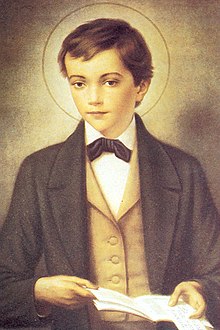Saint Dominic Savio | |
|---|---|
 A prayer card depicting St. Dominic Savio | |
| Confessor | |
| Born | 2 April 1842 San Giovanni, a frazione of Riva presso Chieri, Piedmont, Sardinia-Piedmont[1] |
| Died | 9 March 1857 (aged 14) Mondonio, a frazione of Castelnuovo d’Asti, Piedmont, Kingdom of Sardinia (today Castelnuovo Don Bosco, Italy)[1] |
| Venerated in | Catholic Church |
| Beatified | 5 March 1950, Rome by Pope Pius XII |
| Canonized | 12 June 1954, Rome by Pope Pius XII |
| Major shrine | The Basilica of Mary Help of Christians in Turin (his tomb)[2] |
| Feast | 6 May (formerly 9 March)[3] |
| Patronage | Choirboys, falsely accused people, juvenile delinquents[4] |
Dominic Savio (Italian: Domenico Savio; 2 April 1842 – 9 March 1857) was an Italian student of John Bosco who became a Catholic saint. He was studying to be a priest when he became ill and died at the age of 14, possibly from pleurisy.[5] He was noted for his piety and devotion to the Catholic faith, and was canonized a saint by Pope Pius XII in 1954.
Bosco regarded Savio very highly, and wrote a biography of his young student, The Life of Dominic Savio. This volume, along with other accounts of him, were critical factors in his cause for sainthood. Despite the fact that many people considered him to have died at too young an age (14) to be considered for sainthood, he was considered eligible for such a singular honour on the basis of displaying "heroic virtue" in his everyday life.[6] Savio was canonised a saint on 12 June 1954 by Pope Pius XII, making him the youngest non-martyr to be canonised in the Catholic Church,[7] until the canonisations of Francisco and Jacinta Marto, the pious visionaries of Fatima, in 2017.
- ^ a b Arduino, Fabio. "Domenico Savio", Santi e Beati; Retrieved on 24 November 2006.
- ^ Saint Dominic Savio: Patron Saint of Choirboys: 1842 – 1857; Boychoirs.org: Retrieved on 24 November 2006.
- ^ "Friday-Saturday-Sunday- March 8–10, 2002"; Dailycatholic.org:volume 13, no. 45; Retrieved on 24 November 2006.
- ^ "Saint of the Day, March 9", Saint Patrick Catholic Church, Washington, D.C. Archived 27 December 2011 at the Wayback Machine Retrieved 2 March 2012.
- ^ Bosco, John. Memoirs of the Oratory of Saint Francis de Sales, (Daniel Lyons, trans.) New Rochelle, New York. Don Bosco Publications, 1989. Chapter 6, footnote 19; Retrieved on 24 November 2006.
- ^ "McNamara, Robert. "St. Dominic Savio", Saints Alive 24 November 2006". Archived from the original on 1 August 2018. Retrieved 1 August 2018.
- ^ Dominic Savio Altar, Basilica of Our Lady Help of Christians; Retrieved on 24 November 2006